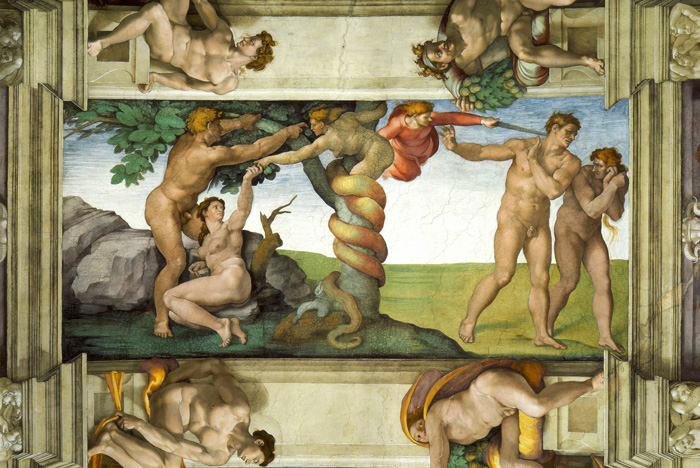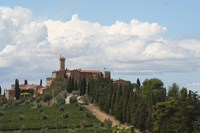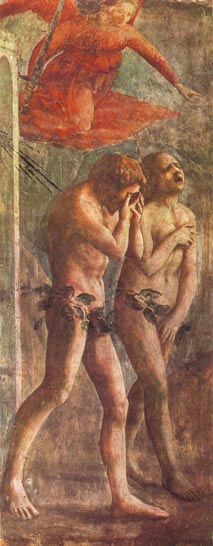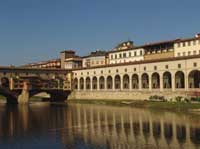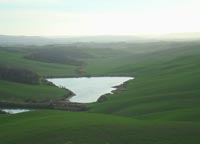| |
|
| |
|
|
|
|
|
|
| |
 |
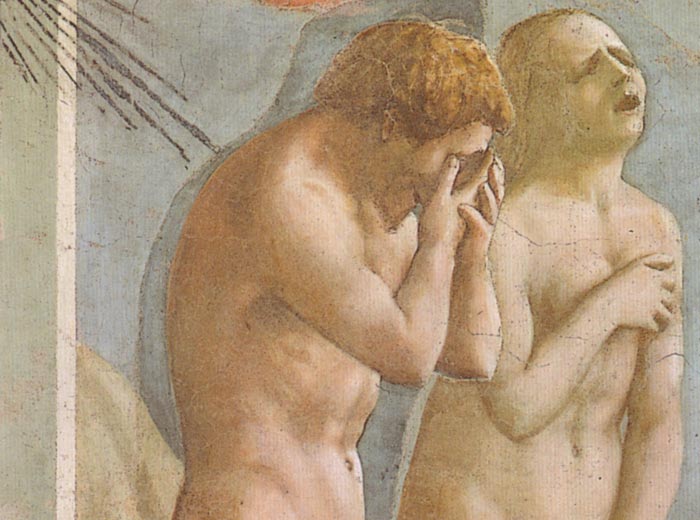 |
| |
Masaccio, Cacciata dei progenitori dall'Eden, La Cappella Brancacci , chiesa di Santa Maria del Carmine di Firenze
|
|
 |
 |
| |
|
|
|
| |
|
Masaccio | Expulsion from the Garden of Eden
|
|
|
|
| |
|
| The Expulsion from the Garden of Eden is a fresco by the Italian Early Renaissance artist Masaccio. The fresco is a single scene from the cycle painted around 1425 by Masaccio, Masolino and others on the walls of the Brancacci Chapel in the church of Santa Maria del Carmine in Florence. It depicts the expulsion of Adam and Eve from the garden of Eden, from the biblical Book of Genesis chapter 3, albeit with a few differences from the canonical account.
Masaccio is regarded as the founder of Italian Renaissance painting, a view established within a decade of his death. Vasari correctly perceived that Masaccio ‘always followed as best he could in the footsteps of Brunelleschi and Donatello, even though he worked in a different medium’.
Among the painters of his time, he was the first to organize his compositions according to the system of linear perspective developed by Brunelleschi. He thus transposed into painting the mathematically proportioned spaces and Classical architectural vocabulary of Brunelleschi’s buildings, as well as the realistic anatomical structure, heavy draperies and human grandeur of Donatello’s statues. He was also inspired by the paintings of Giotto and the art of antiquity. Masaccio’s revival of Giotto’s monumentality and concentration on volume was, like the writings by humanists on Florentine history, an affirmation of the greatness and enduring values of the Florentine past. The features that distinguish Masaccio’s work most sharply from that of Giotto are his rendering of objects and figures as fully three-dimensional solids with gravitational weight; the measurability of his pictorial space; his depiction of light and shadow as if light were entering this space from a single source; and his portrayal of figures as conscious individuals who confront issues of profound
moral moment and exist and act in real time as well as real space.
The Expulsion Of Adam and Eve from Eden demonstrates the fascination of Renaissance artists with Greek mythological subjects. Note how the pose of Eve is apparently based on the so-called Venus Pudica pose that became the norm for the nude Aphrodite figures in the Late Classical period.[3]
Masaccio, according to Berenson, ‘gave Florentine painting the direction it pursued to the end’ and surpassed all other painters of his age. Although later painters were capable of ‘greater science, greater craft, and greater perfection of detail’, there was never a
‘greater reality’ or ‘greater significance’ than in the works of Masaccio.[1]
The chapel was superbly restored, with the removal of accumulated candle soot and layers of 18th century egg-based gum which had formed a mold.
|
|
|
|
| |
|
Possible sources of inspiration
|
|
|
Many possible sources of inspiration have been pointed out that Masaccio may have drawn from. For Adam, possible references include numerous sculptures of Marsyas (from Greek Mythology) and certain crucifix done by Donatello.
The scene has been compared to Massolino's fresco of the Temptation on the opposite wall. Masaccio's concrete and dramatic portrayal of the figures, his truly innovative Renaissance spirit, stand in striking contrast to Masolino's late Gothic scene, lacking in psychological depth. In Masaccio's painting man, although a sinner, has not lost his dignity: he appears neither debased nor degraded, and the beauty of his body is a blend of classical archetypes and innovative forms of expression.
For Eve, art analysts usually point to different versions of Venus Pudica, such as Prudence by Giovanni Pisano. One cannot help thinking of earlier interpretations of the Graeco-Roman Venus Pudica in 14th century (e.g. by Nicola Pisano). But Masaccio's Eve is only similar to them in her gesture, because her body expresses dramaticaly all the suffering in the world. Scholars have also pointed out the likely precedents for the figure of Adam (e.g. classical models such as Laocoon and Marsyas).
Debold von Kritter (1975) suggested that the combination of the Temptation and the Expulsion on the entrance piers with the cycle of scenes from the Life of St Peter in the interior of the chapel corresponds to comparisons of Peter with Adam and Eve in theological texts by Nicholas of Lyra and Maximus of Turin, according to which the original sinners Adam and Eve have their counterpart in St Peter, the redeemed sinner who through his own
example and the institutions of the Church becomes the gatekeeper of paradise and leads mankind to redemption.[1]
|
|
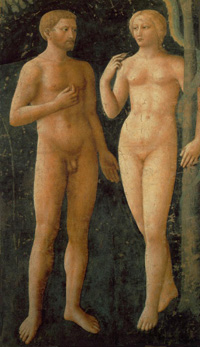
Tentazione di Adamo ed Eva di Masolino, sulla parete opposta
|
Cover up and restoration
|
Three centuries after the fresco was painted, Cosimo III de' Medici, in line with contemporary ideas of decorum, ordered that fig leaves be added to conceal the genitals of the figures. These were eventually removed in the 1980s when the painting was fully restored and cleaned.
|
During the restoration, a team directed by Ornella Casazza of the Art
Superintendency of Florence gingerly removed centuries of soot laid down by votive candles and oil lamps.
Within a few decades of the chapel's completion, an altar was installed that
covered the edges of several frescoes and concealed a number of small paintings, which were thus shielded from
light and pollution. When the heavy marble was recently moved, the original colors were revealed in all their
brilliance.
The frescoes have an intense radiance, making it possible to see very clearly the shifts in emphasis between Masolino's work and that of Masaccio (contrast the serenity of Masolino's Temptation of Adam and Eve with the excruciating agony of Masaccio's Expulsion of Adam and Eve from Paradise).
The restoration also highlights Masaccio's mastery of chiaroscuro (light and shade), which, combined with his grasp of perspective, created much marvel and was consciously copied by the Florentine painters of the 15th century.
The frescoes were very largely executed in buon fresco on sections of wet plaster, with additions in fresco a secco (after the plaster had dried) for the foliage of the trees. Whether Masaccio used sinopie is not known. The intonaco of the wall frescoes in the Brancacci Chapel has never
been detached.[1]
|
|
|
|
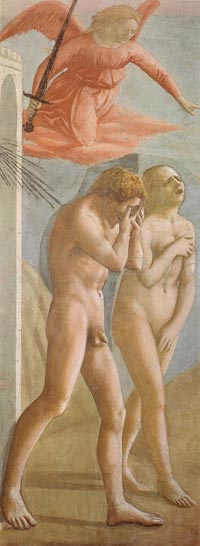 |
|
|
Before and after the restoration works
|
Influence on Michelangelo
|
|
Michelangelo, The Fall of Man and the Expulsion from the Garden of Eden, with four Ignudi, 1510 (fresco), Sistene Chapel ceiling, Vatican Museums and Galleries, Vatican City
|
Masaccio provided a large inspiration to the more famous Renaissance painter Michelangelo, due to the fact that Michelangelo's teacher, Domenico Ghirlandaio, looked almost exclusively to him for inspiration for his religious scenes. Ghirlandaio also imitated various designs done by Masaccio. This influence is most visible in Michelangelo's "The Fall of Man and the Expulsion from the Garden of Eden" on the ceiling of the Sistine Chapel.
Masaccio's depiction shows Adam and Eve being expelled from the Garden of Eden. Meanwhile, Michelangelo's depiction shows Adam and Eve picking the fruit from the Tree of Knowledge and then being expelled from the Garden of Eden.
Adam and Eve are shown in a before and after scene, reaching for the forbidden fruit and banished as a result. Michelangelo’s figures are large and exceedingly muscular, painted as a true sculptor might paint them. In the banishment, Michelangelo also portrays a humiliated and naked Adam and Eve, and an angel in orange with a sword, only this sword it at Adam’s throat, which really drives home the serious consequence of Adam’s action.
Differences from Genesis
|
The main points in this painting that deviate from the account as it appears in Genesis:
Adam and Eve are shown in the nude. Although this increases the drama of the scene, it differs from Genesis 3:21 (KJV) which states, "Unto Adam also and to his wife did the LORD God make coats of skins, and clothed them."
Only one Cherub angel is present. Genesis 3:24 states, "So he drove out the man; and he placed at the east of the garden of Eden Cherubims, [...]" (-im being the original Hebrew plural ending of Cherub, doubled with an English plural in this version).
The arch depicted at the garden entrance does not appear in the Biblical account.
|
|
|
| |
|

|
|
|
[1] From Grove Art Online | Masaccio | article url: www.oxfordartonline.com
[2] The church and convent of the Carmine in Florence are very ancient. They were founded shortly after the middle of the thirteenth century by a group of Carmelite monks from Pisa, the first of the great structures built by the mendicant orders in Florence. The oldest parts of the convent are those surrounding the current cloister rebuilt during the seventeenth century: in particular the old chapter house that overlooks the portico and the Sala del Cenacolo decorated in 1581 by Alessandro Allori.
In the church we find the Brancacci Chapel, with the frescoes of the Life of Saint Peter by Masaccio and Masolino. Created between 1425-1427, the frescoes were left incomplete and finished by Filippino Lippi between 1481 and 1482.
The Sala della Colonna in the convent of the Carmine houses a number of detached frescoes and sinopie (underpaintings) from the same convent and church, in particular two frescoes from the beginning of Filippo Lippi’s career, frescoes by Gherardo Starnina from the destroyed Chapel of San Girolamo and two sinopie attributed to Masaccio and Masolino found in the Brancacci Chapel.
[3] The figure of Eve in the Expulsion assumes the arm and hand gestures of the Venus de’ Medici (Florence, Uffizi), a Roman copy of a Praxitilean original, first recorded in the Villa Medici in Rome in 1638. Masaccio may have known the statue of a similar type that the humanist Benvenuto da Imola saw in a Florentine house in the second half of the 14th century, or he may have derived the gestures from the earlier antique adaptation in the standing, nude figure of Prudence at the base of Giovanni Pisano’s pulpit (1302–10) in Pisa Cathedral.
The Aphrodite of Cnidus (Knidos) by Praxiteles (c.350 BC) is the first monumental female nude in classical sculpture.
It is the Capitoline Venus, however, where both the breasts and pubis are self-consciously covered, that is the archetype of so many representations of the female nude that follow, including Masaccio's "The Expulsion" and Botticelli's "The Birth of Venus." This is the pose of the Venus Pudica or "modest Venus," in which the arms envelope a body that is both sensuous and distant.
Venus Pudica
Venus pudica is a term used to describe a classic figural pose in Western art. The word "pudica" comes to us by way of the Latin "pudendus", which can mean either external genitalia or shame, or both simultaneously.
The Aphrodite of Knidos and Her Successors: A Historical Review of the Female Nude in Greek Art (1995) by Christine Mitchell
|
|
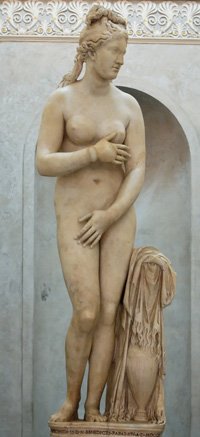 Capitoline Venus |

Art in Tuscany | Giorgio Vasari's Lives of the Artists | Masaccio, painter of Florence
Giorgio Vasari | Le vite de' più eccellenti architetti, pittori, et scultori italiani, da Cimabue insino a' tempi nostri | Masaccio | Pittore Fiorentino
Ken Shulman, Anatomy of a Restoration: The Brancacci Chapel, Walker & Co, 1990
Umberto Baldini and Ornella Casazza, The Brancacci Chapel, New York, 1990
Diane Cole Ahl, The Brancacci Chapel, in The Cambridge Companion to Masaccio, ed. Diane Cole Ahl, Cambridge, 2002, 138-157.
|
This page uses material from the Wikipedia articles Expulsion from the Garden of Eden published under the GNU Free Documentation License.
Wikimedia Commons has media related to: Expulsion from the Garden of Eden (Masaccio)
|
 |
|

Podere Santa Pia, a thoughtfully restored holiday rental house is located in the magic truffle area, cuddled by the sweet hills of the Maremma Region. The country house is immersed in the utmost quietness where total privacy is guaranteed, in a scenic location 50 minutes away from both the sea and the Val d'Orcia National Park.
Not far from Cinigiano and clearly visible from Podere Santa Pia, is the famous Castle of Poggio alle Mura, also known as Villa Banfi and home to one of the most popular producers of Brunello di Montalcino D.O.C.G. wine. Set in 7100 hectares of land in the Montalcino area, Castello Banfi il Borgo is one of the most important wine producers in Tuscany. This is the land where the DOC wines Montecucco and Brunello are produced. So, the surrounding countryside is the ideal area for an uncommon wine tour, visiting small farms producing wine and excellent extra virgin olive oil.
Italy's Tuscany region offers the visitor such a feast of culinary delights it really is difficult to know where to start. If you love great wines, great food and great scenery, a wine tasting tour makes an ideal holiday.
And within 90 minutes drive, there are towns and cities of great cultural and historical importance and beauty, with historical figures and legends creating a magical sense of history, among them St Francis of Assisi, Pia di Tolomei, and master painters as Luca Signorelli, Fra Angelico, Ambrogio Lorenzetti, Giotto and Piero della Francesca.
Case vacanza in Toscana | Podere Santa Pia
|
| |
|
|
|
|
|
|

. |
Castello Banfi |
|
Podere Santa Pia |
|
Podere Santa Pia, garden view, December |
| |
|
|
|
|
|
|
|
|
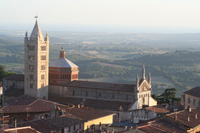 |
Val d'Orcia" between Pienza e San Quirico d’Orcia. |
|
Corridoio Vasariano, Firenze |
|
Massa Marittima |
|
|
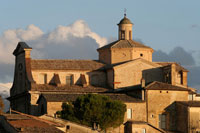
|
|
|
Crete Senesi, surroundings
of Podere Santa Pia |
|
Montefalco |
|
The abbey of Sant'Antimo |
| |
|
|
|
|
 |
Podere Santa Pia has some wonderful views over the beautiful valley below. The house creates a perfect platform from which to enjoy the breathtaking scenery of this unique paradise.
|
| |
|
|
| |
|
|
|
| |
|
|
|
| |
|
|
|
| |
|
|
|
| |
|
|
|
| |
|
|
|


